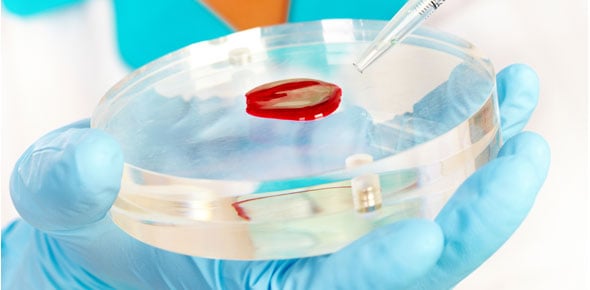The calcaneus is a bone located in the:
The recommended antiseptic for cleaning capillary puncture sites is:
This is a sharp-pointed device used to make capillary punctures:
Which of the following are required characteristics of capillary...
What is the purpose of warming the site before capillary puncture?
Capillary specimens contain:
Excess anticoagulant in underfilled microtubes can negatively affect...
After making a blood smear:
This is a term for the bottom surface of the heel:
A cyanotic extremity would:
According to CLSI, depth of heel puncture should not exceed:
A blood smear is:
Tests affected by povidone-iodine contamination of a capillary...
Which of the following statemenst most accurately describes capillary...
This test is typically performed on capillary blood:
Reference values for this test are higher for capillary specimens:
Jaundice in a newborn is associated with high levels of:
Which of the following is the safest area of an infant's foot for...
"feather" is a term used to describe the appearence of:
If venous blood is placed in a microtube, it is important to:
The best way to mix blood in an additive microtube is to:
Which test must be collected by venipuncture?
Which color-coded microtube would be used to collect a CBC?
According to the CLSI standards capillary punctures must not be...
UV light can cause the bilirubin in a specimen to break down.
Which of the following action words associated with capillary puncture...
Osteochondritis is:
Whorls as related to capillary puncture are:
A laboratory report form should state that a specimen has been...
It is necessary to control the depth of lancet insertion during heel...
Lancets with permanently retractable blades are disposed of in the:
"arterialized" means:
If collected by capillary puncture, which of the following specimens...
In which of the following areas does capillary specimen collection...
Neonatal screening is the testing of:
A list of capillary puncture equipment would exclude:
Which of the following is te medical term for a finger bone?
The composition of blood obtained by capillary puncture more closely...
It is inappropriate to apply a bandage to a capillary puncture site on...
Which of the following steps should be omitted from infant heel...
Which of the following can be a complication of a heel puncture that...
Fluidin the spaces between the cells is called:
The temperature of heel warming devices should never exceed:
Falsely decreased bilirubin results can be caused by:
Strong repetitive pressure, such as squeezing or milking a site during...
Which of the following action taken while filling microcollection...
An acceptable routine blood smear:
Which of the following is normally a proper site for finger puncture...
Which of the following equipment is used to collect a manual packed...
Blood collected by puncturing the skin is called capillary blood...
A recommended capillary puncture site on children 2 years of age or...
Capillary puncture is a poor choice for specimen collection if the...
One purpose of wiping away the first drop of blood (fig. 10-4] during...
A microcollection container is sometimes called a:
Which of the following patient conditions would make capillary...
Neonatal sccreening for this disorder is required by law in the United...
Which of the following sites would normally be eliminated as a...
A capillary puncture that parallels the whorls of the fingerprint...
An infant may require a blood transfusion if blood levels of this...
Situations that require a venipuncture instead of capillary puncture...
Errors in capillary glucose results have been attributed to:
Referring to fig. 10-1, identify the letters of the fingers that are...
The antiseptic must be completely dried before performing capillary...
A blood smear prepared from an EDTA specimen should be made:
If the following tests are collected from a patient by capillary...
A differential test is unable to determine:
Which numbered arrows on the diagram of an infant's floot in Fig....
Phenylketonuria is a:
Which of the following would be excluded from a list of reasons why...
Which of the following collection devices fill by capillary action?
The distance between the skin surface and the bone in the end segment...
CBG specimens are collected in:
When making a blood smear by hand using two glass slides, the typical...
Which of the following is least likely to contaminate a PKU test?
Pain fibers decrease below the capillary bed.
This is the abbreviation for a pulmonary function test:
Proper finger puncture technique would exclude:
Collection of a thick blood smear may be requested to detect:
Which statement concerning capillary blood gases is untrue?
If the phlebotomist makes a blood smear that is too short, he or she...
It is unlikely that holes in a blood smear would be caused by:
The major blood vessels of the skin are located:
Which statement concerning microhematocrit tubes is incorrect?
You need to collect blood cultures, and green, tight blue, and purple...
Correct newborn screening test collection or handling includes:
Which of the following would be least likely to introduce excess...
Which of the following can result in microclot formation in a specimen...
In order to get enough blood from a capillary puncture the...
A blood smear is required for this test:
Microhematocrit tubes with a red band on one end contain:
Which of the following equipment is reusable?
In an infant's heel, the area of the vascular bed that is rich in...
Which of the following equipment should be delted from a list of...
During multisample capillary specimen collection, blood smears and...
For accurate results, the heel must be warmed before collecting a...
Iron filings used in capillary blood gas collection:
Which of the following is a newborn screening test?
Which of the following capillary puncture techniques is incorrect?
Hemolysis of a capillary specimen can erroneously elevate results for...
Which capillary specimen should be collected separately?
















